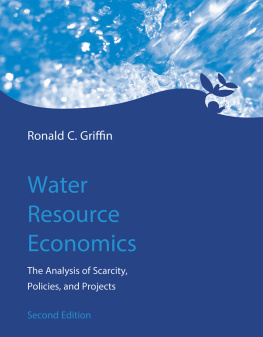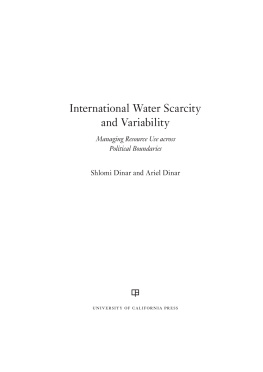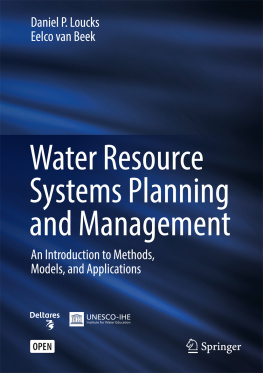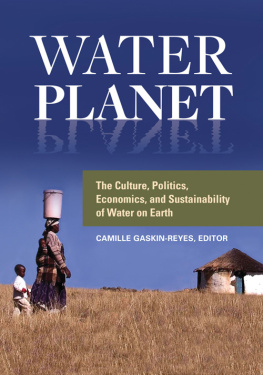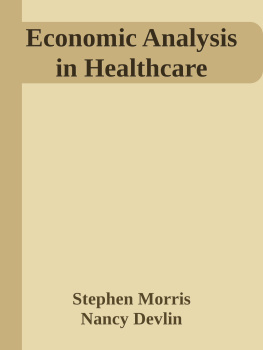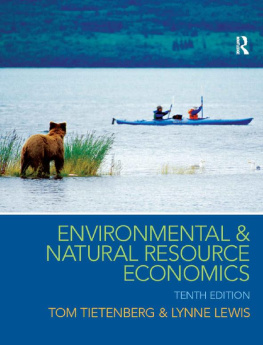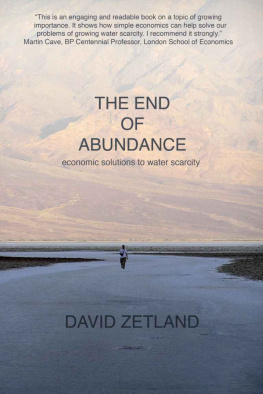Water Resource Economics
The Analysis of Scarcity, Policies, and Projects
second edition
Ronald C. Griffin
The MIT Press
Cambridge, Massachusetts
London, England
2016 Massachusetts Institute of Technology
All rights reserved. No part of this book may be reproduced in any form by any electronic or mechanical means (including photocopying, recording, or information storage and retrieval) without permission in writing from the publisher.
This book was set in Times New Roman by Toppan Best-set Premedia Limited. Printed and bound in the United States of America.
Library of Congress Cataloging-in-Publication Data
Names: Griffin, Ronald C., author.
Title: Water resource economics : the analysis of scarcity, policies, and projects / Ronald C. Griffin.
Description: Second edition. | Cambridge, MA : MIT Press, [2016] | Includes bibliographical references and index.
Identifiers: LCCN 2015038392 | ISBN 9780262034043 (hardcover : alk. paper)
eISBN 9780262334044
Subjects: LCSH: Water resources developmentEconomic aspects. | Water resources developmentGovernment policy. | Water-supplyEconomic aspects. | Water-supplyGovernment policy.
Classification: LCC HD1691 .G745 2016 | DDC 333.91/15dc23 LC record available at http://lccn.loc.gov/2015038392
10987654321
d_r0
Dedicated to wondrous, lovely Trish
With a shout out to water economics sage Robert A. Young (19312013) who told his students if you want to be a good resource economist, study waterall the problems are there.
Preface
Who is this for? What should they know?
An advance of this second edition is to incorporate water scarcity risk via a new, optional-reading chapter as well as some risk-attentive influences elsewhere in the text. Other updates address active water markets, including the predominant one in Australia, and the new US directions for conducting water project analysis. The water pricing chapter has been modernized to deal more sharply with block rates and the rising importance of better pricing doctrine. There are new appendixes focusing on inputoutput analysis, water footprinting and virtual water, and cost allocation. These appendixes provide reference material for specialized and sometimes contentious situations. Attention to recent literature and issues is improved throughout the book.
**********
Because economics brings powerful insights to water management, books like this should reach beyond an audience of economists. Therein lies a challenge, for few water managers or planners have invested in economics. Because they come mainly from the engineering and science disciplines, most water professionals have received limited training in economics. For these readers, its rarely practical to study microeconomics and natural resource economics before getting schooled in water resource economics. Few have that kind of time or patience. For these reasons this text incorporates the prerequisite economics so that it can be useful for economists, engineers, natural scientists, and others.
The economist reader possesses conceptual knowledge that is readily adapted to water resources, especially if that reader has studied natural resource economics. The comparative advantage for engineers and natural scientists is their strong math skills. With the aid of mathematics, important economics principles can be accessed quite quickly. It turns out that the initial wisdom emerging from economics is quite practical, yielding positive feedback regarding the merits of knowing some water resource economics. You dont have to go all the way to the end to enjoy benefits. Such affirmations inspire continued study too. Fortunately, many dedicated individuals consider themselves to be stewards of our water resources, making it easier for them to welcome new tools.
The intended reader includes graduate students of many disciplines, water planning professionals with baccalaureates, and upper level undergraduates possessing solid math backgrounds. The mathematics required are optimization (setting derivatives equal to zero) and integral calculus (finding areas under curves). Some of the economics contained in this book is not mathematically oriented, but the insights enabled by mathematics are indispensable. This edition contains a new chapter on the increasingly important matter of risk. Because of its more advanced methods, the risk chapter is optional reading, and other chapters do not rely on it. The risk tools of this chapter are developed progressively to make them accessible to a wider group of readers.
While it is helpful for the reader to have prior familiarity with microeconomics or natural resource economics, all the necessary economics is developed here. In this way, self-study becomes practical too. However, the noneconomist reader will have to be diligent, for the path is a steady climb. Chapters 2, 3, and 5 are pivotal in this regard (excepting sections 3.4 to 3.6). The reader is advised not move forward until good grasp of the present topic is achieved. Missed ideas and concepts will become detrimental later on, as no economics tools are developed here unless they are useful in water planning or management. For the reader desiring only a foundational exposure to water resource economics, chapters 1 to 3, 5, 7 to 9, and 13 should serve nicely. An instructor reports using chapter 13 as a first reading because of its brevity and cross-cutting overview. Another kickoff option is to read a summary article with broad sweep such as Hanemann (2006), Olmstead (2010), or Griffin (2012b).
To bind empiricism (number crunching) and theory more tightly, all graphic portrayals of economics theory and most calculations are performed using Mathematica, an analytic mathematics software package. Consequently this material is less abstract than what is usually encountered in economics. The programming code for these graphics and analysis is downloadable at the authors website, . The makers of Mathematica distribute a free application, CDF Player (www.wolfram.com/cdf-player), enabling users of any computer platform to read the programming code and output of Mathematica programs. Retrieval of these programs is optional.
Disciplines such as engineering, geography, law, and political science also have things to say about the water problems considered here. Good policy design commonly draws insights from many places. With this book we follow a purer courseadhering strictly to economics directives in developing management advice. This approach does not dilute or muddy the messages of economicswhich would occur if one pursued some manner of blending, as performed in typical water management books. We will be true to the economics source material, so as to let it stand on its own two feet and be clearly visiblefor its successes, possibly its faults, and certainly for its differences. As a result it will be interesting for readers to contrast economics ideals about water to their usual thinking about needed actions.
To keep things manageable, we will focus on the scarcity of water quantity. Yes, water quality is a serious topic too, and economics has a lot to say about it. There are even important social problems in which issues of water quantity and quality are intertwined. It suits an introductory text, however, that our scope be workably delimited.
A final direction of this book warranting explanation is its geopolitical focus. US situations and applications are emphasized whenever it is important to select an institutional or physical context. The tools of water resource economics presented in this text are devoid of US definition, but water resource economics is an inherently policy-oriented field of inquiry. The ultimate contributions of water resource economics are to improve management policies. To speak about improving policy it is often useful to have a starting place. Here US policy constitutes the primary background.

